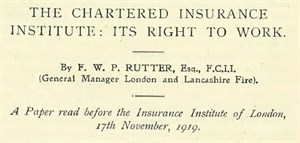In 1919, F. W. P. Rutter (President for the period 1910-11 of what was then the Insurance Institute of Great Britain and Ireland) gave a lecture to the Insurance Institute of London, entitled ‘The Chartered Insurance Institute: its Right to Work’. In his address Mr Rutter laid out his vision for what he hoped the Chartered Insurance Institute (CII) could become.

Alongside his belief that the CII should provide a well-rounded education to its members, Mr Rutter – or Sir Frederick as he was later to become – highlighted the three elements of the Charter he considered most important to the CII’s purpose:
First: that the Institute should have a library and should collect all data and records connected with insurance, especially having regard to legislation and legal decisions. That is to say, the Institute should have a librarian and a building of its own, where all these records could be accumulated, recorded, classified and referred to.
Second: that the Institute should, as the phraseology goes, “exercise professional supervision and control over the members of the Institute, to safeguard their interests and welfare, to further their advancement and to promote whatever may lead to the improvement of the status of insurance officials in general, and the members of the Institute in particular”.
Third: that the Institute should promote and encourage benevolent funds and other such provisions for old age, sickness, misfortune and death, and generally assist necessitous members, widows and children.

Furthermore, in order to help the CII achieve its aims, Sir Frederick made the following declaration:
The main point for the present, to my mind, is that this Institute should become an obvious Institute, with its own building or, at any rate, adequate premises and accommodation where the members, not only of the London Institute, but of all the Institutes throughout the Kingdom, whenever they happen to be in London, can have access to manuals, treatises and records; and where they could foregather. It seems to me that it is only by some such forward and bold step that we can give the full force and power to the arm of the Chartered [Insurance] Institute.
This lecture was enormously well received and has essentially shaped the activities of the CII for almost a century. Incidentally, each of the elements that have formed the new Strategic Manifesto are covered in Rutter’s lecture – as a member wrote to us recently: “While insurance often seeks to reinvent itself, the bottom line is that a huge amount of that reinvention has gone before.”
Immediately following this lecture, a special fund was set up in order to enact Rutter’s vision, with Mr Rutter’s company, The London & Lancashire, donating £1,000 (the equivalent of approximately £51,000 today). Within the first few months, the special fund had amassed donations exceeding £15,000 (the equivalent of approximately £750,000 today) and continued to receive smaller donations from various companies, local Institutes and individuals during the next 13 years. By 1932, the fund total was approximately £31,000 (the equivalent of approximately £1.9m today) and this money was used to purchase the freehold for the Aldermanbury site.

